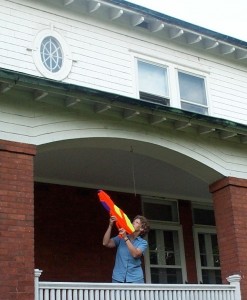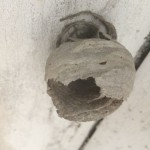Anxious about that wasp nest near the back door that you hadn’t noticed till now?
Not to worry. By this time of year, most wasp colonies have disbanded. Fertile young queens fly off to hide under tree bark or some other place to wait out the cold weather — to chill out, as it were. And all those worker wasps? Their lifespan is over and most will wander off to die, unremarked in the great scheme of things.
Those empty nests they leave behind — it’s easy to think that something live is still lurking there; that come next year, those same nests will still be that colony’s home-sweet-home. And indeed a few workers might hunker down in the nest — but rarely if ever do they survive the winter. Even if they did, they’d have no purpose in life without a queen to care for come spring. And new queens want new homes.
Those worker wasps would be goners, pure and simple.
Come spring, though, it might be tricky to tell those old nests from new. And though wasps provide clear services as predators of pesky caterpillars, still, a nest too close to home could be a hazard.
So that you don’t get unduly worried next year (and miss an easy way to tell which nests are new and worth dealing with), get rid of old nests now.
Here’s your simple, tried-and-true IPM solution. First, take a close look at the undersides of porch railings, the eaves over doors and window, the undersides of picnic benches or swing sets — you get the idea. Note where the nests are.

Then on some cold night take a stick, broom handle, high-pressure hose, shop vac — even your kid’s super-soaker — to every abandoned nest you can get to. Vacuum them up or knock them to the ground. Then just for good measure, stomp on them with your boots.
Why choose a cold night? Just in case, that’s why. If a few wasps remain, they need light to see by. Plus, wasps move very slowly on cold nights. But how to manage without a light that you can see by? By using red-filtered light. You might have a flashlight on hand with a red-filter lens you can screw on. Or you could just buy “light filter film” online. (Get the “orange-red” kind.) Then get out your scissors, cut a piece the size of your lens — a piece that include four half-inch tabs at each point on the compass (as it were). Next, fix the filter snugly over the lens with tape or rubber bands.
In fact, you could even use red holiday wrap. But you’d have to cut a strip wider than your flashlight (you want an inch or two to spare) and fold it end over end to make a small square about 1/8 in thick — then do the tape or rubber-band thing.
And there you have it. Now all you need is a chilly night, in abundance this time of year. And come next spring, we’ll walk you through the same process — this time, to deal with the new nests you find. (And no pesticides needed. Mostly.)

